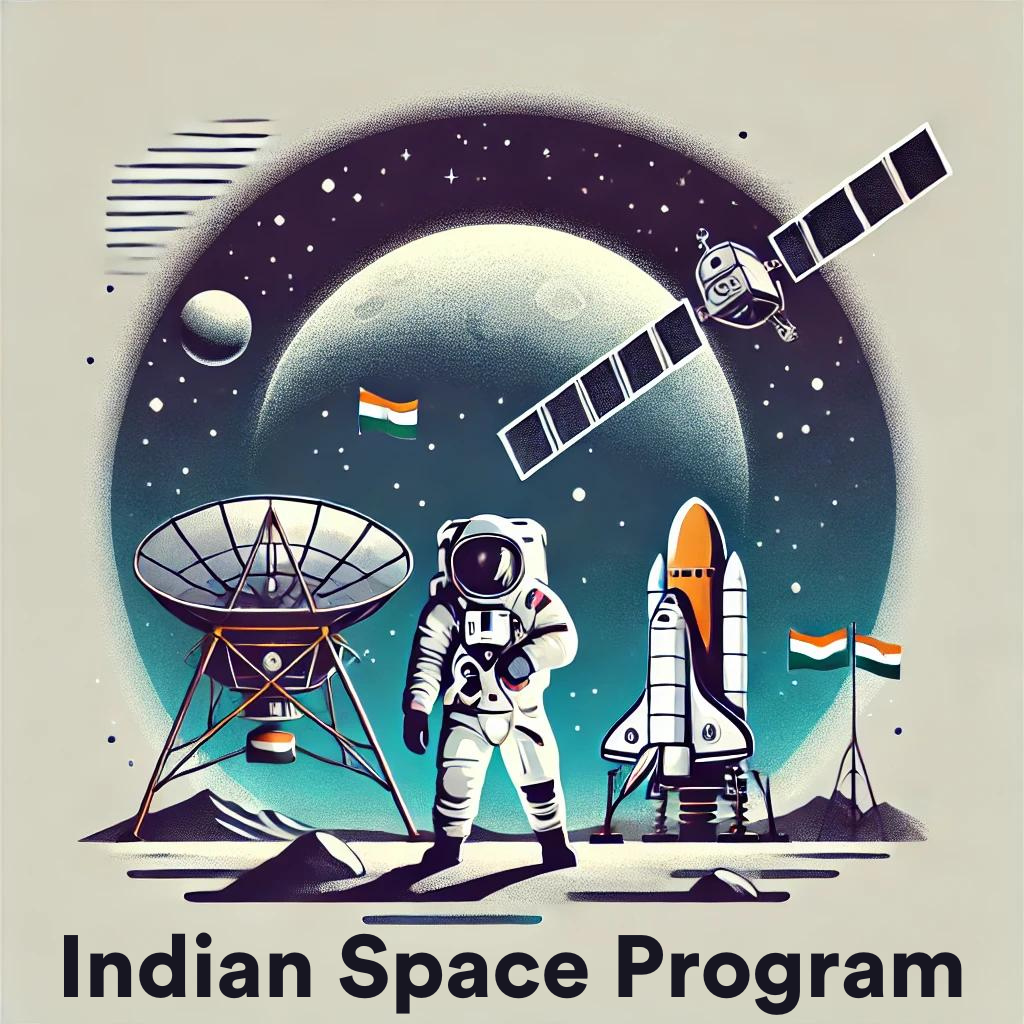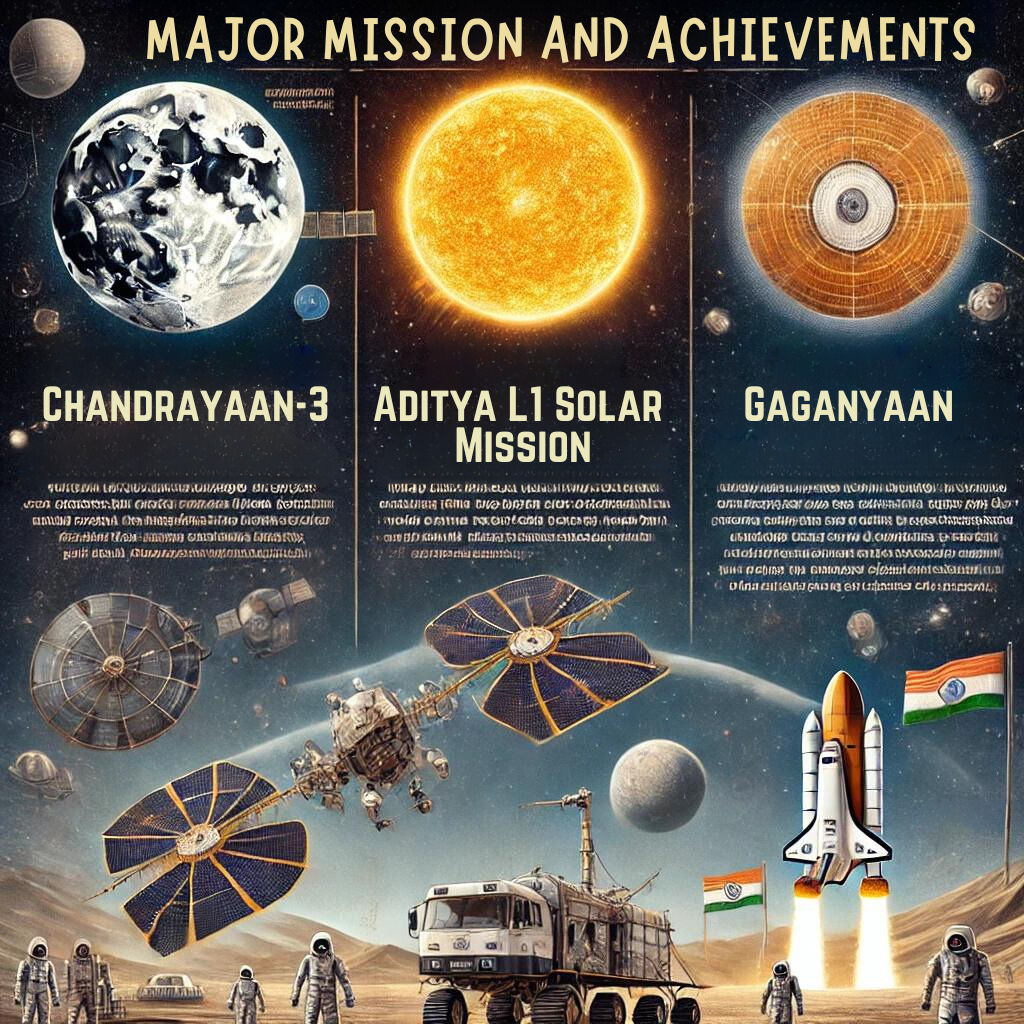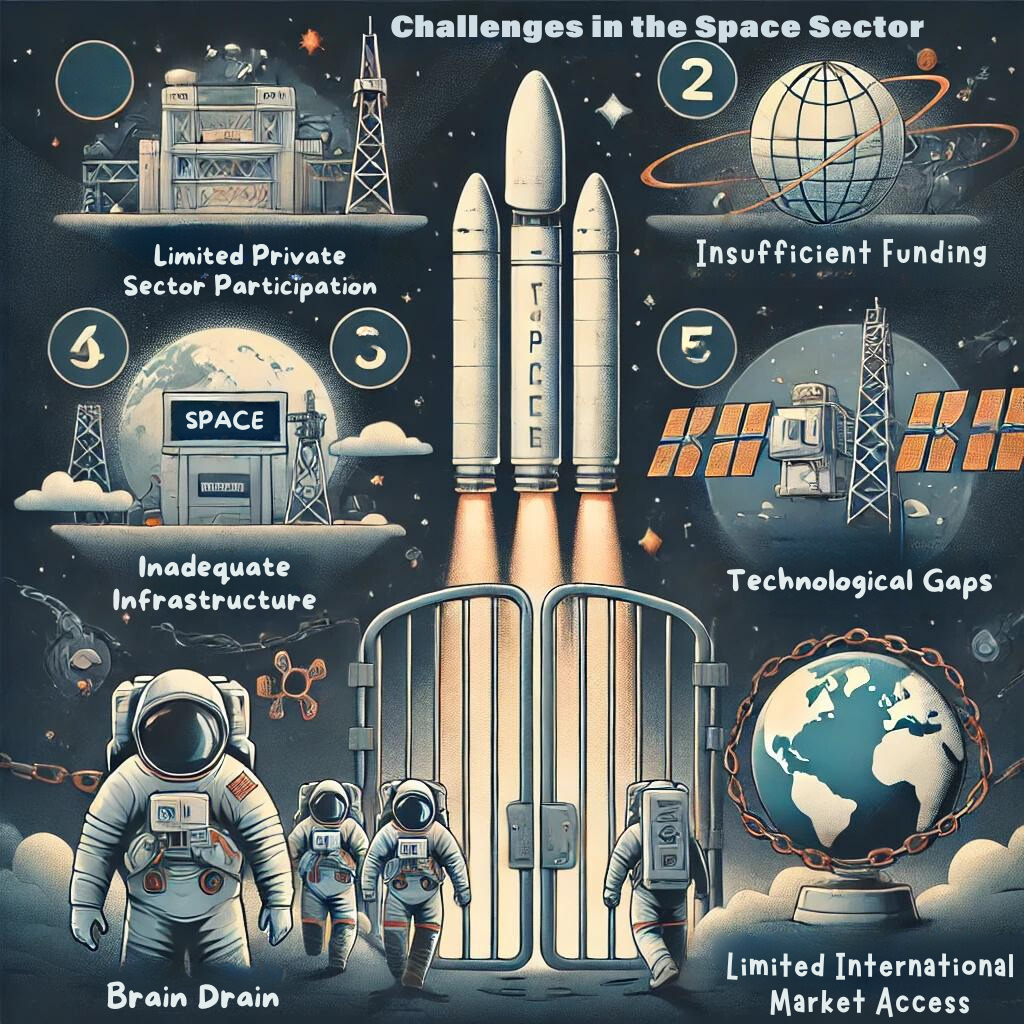India’s space sector has seen remarkable growth and success over the past year. From the Chandrayaan-3 lunar landing to the Aditya L1 Solar Mission, ISRO has showcased its capabilities globally. The Gaganyaan human spaceflight program is also making significant progress. Additionally, the country has ambitious plans for future space missions, including establishing an Indian space station by 2035. However, to fully harness its potential, India needs to focus on commercializing space technologies and fostering a strong private sector in space.
| GS Paper | General Studies III |
| Topics for UPSC Prelims | India’s Space Sector, Chandrayaan-3 lunar landing, Aditya L1 Solar Mission, Gaganyaan, XPoSat, INSAT-3DS, National Space Day, NewSpace India Limited, Indian Space Policy 2023, NISAR mission, International Space Station, Pushpak reusable launch vehicle, Missile Technology Control Regime, 2019 ASAT test. |
| Topics for UPSC Mains | Current Major Developments in India’s Space Sector, Major Issues Related to the Indian Space Sector. |
Origin of the Article
This editorial is based on “Since Chandrayaan-3, what has India’s space programme been up to?” published in The Hindu on August 23, 2024. The article discusses India’s advancements in space exploration and future strategic plans.
Relevancy for UPSC Students
For UPSC aspirants, understanding this topic is crucial as it aligns with the GS Paper-3 syllabus, covering Science and Technology and the Achievements of Indians in this field. Knowledge of India’s space missions and challenges will aid in answering questions related to technological advancements and national development.

Why in News
The topic is crucial for the UPSC Civil Services exam as it underscores India’s growing prowess in space technology, which is pivotal for both Prelims and Mains. The recent achievements of ISRO, such as Chandrayaan-3, Aditya L1, and the Gaganyaan mission, reflect strategic advancements and emerging opportunities for private players, aligning with previous UPSC questions on the Indian space program and its socio-economic benefits.
Current Major Developments in India’s Space Sector
India’s space sector has seen substantial advancements over the past year, marked by significant achievements in various missions. With the successful Chandrayaan-3 lunar landing, the launch of the Aditya-L1 Solar Observatory, and progress in the Gaganyaan human spaceflight program, ISRO has demonstrated its growing capabilities. Additionally, the sector is witnessing increased commercialization and privatization, alongside efforts in next-generation launch vehicle development and expanding international collaborations.
Advancements in Space Science Missions
India has made commendable strides in space science missions, underscoring its growing expertise and ambition in space exploration.
Chandrayaan-3
Chandrayaan-3 marked a significant milestone in India’s lunar exploration endeavors by successfully landing on the moon. This mission demonstrated India’s capability in space technology, enhancing its position in global space exploration.
Aditya-L1 Solar Observatory
Launched in September 2023, Aditya-L1 is India’s first dedicated solar mission. It aims to study solar activities and their impact on space weather. The mission has already contributed valuable data on solar storms, enhancing our understanding of solar phenomena.
X-ray Polarimeter Satellite (XPoSat)
Launched in January 2024, XPoSat is advancing India’s capabilities in space-based astronomy. This mission focuses on studying X-ray sources in space, providing insights into high-energy astrophysical processes.

Gaganyaan Mission Progresses
The Gaganyaan mission represents a significant leap in India’s human spaceflight ambitions. ISRO has made substantial progress in preparing for this historic endeavor.
First Abort Test
In 2023, ISRO successfully conducted the first abort test (TV-D1) of the crew escape system. This critical test ensures the safety of astronauts in case of an emergency during the launch.
Astronaut Training
Four astronaut candidates have been selected and are undergoing rigorous training. This preparation is crucial for the success of the Gaganyaan mission, ensuring the crew is ready for space travel.
Mission Timeline
The first uncrewed Gaganyaan mission is expected in late 2024, followed by a crewed mission in 2025. This timeline reflects India’s commitment to achieving human spaceflight capabilities.
Commercialization and Privatization Push
The push for commercialization and privatization is reshaping India’s space sector, fostering innovation and economic growth.
NSIL Activities
In May 2024, NewSpace India Limited (NSIL) took over all commercial activities related to Indian Remote Sensing satellite data and products. This move is expected to boost the commercialization of ISRO’s technologies.
Private Ventures
Private ventures are making notable progress, with Agnikul Cosmos successfully launching its SoRTeD-01 vehicle in March 2024. This milestone signifies the growing role of private players in India’s space sector.
Next-Generation Launch Vehicle Development
ISRO is actively working on developing the Next Generation Launch Vehicle (NGLV) to enhance payload capacity and reduce launch costs.
NGLV Design
The NGLV is designed as a three-stage vehicle powered by semi-cryogenic, liquid, and cryogenic engines. This design aims to improve efficiency and cost-effectiveness in satellite launches.
Semi-Cryogenic Engine
ISRO is developing a semi-cryogenic engine for the LVM-3 rocket, with successful pre-burner ignition tests conducted in May 2024. This advancement is crucial for enhancing India’s launch capabilities.
Indian Space Policy 2023
The government-approved Indian Space Policy 2023 emphasizes research and development. This policy aims to foster innovation and expand India’s human understanding of outer space.
Expanding International Collaborations
India is strengthening its international collaborations, enhancing its global presence and capabilities in space exploration.
NSIL and SpaceX Agreement
NSIL signed an agreement with SpaceX to launch the GSAT-20/GSAT-N2 satellite. This partnership showcases India’s pragmatic approach to utilizing international launch capabilities.
Collaboration with NASA
India’s collaboration with NASA for the NISAR mission, expected to launch in early 2025, signifies growing technical cooperation with global space leaders. This mission will enhance our understanding of Earth’s processes.
Astronaut Training in the U.S.
Indian astronaut candidates are set to receive training in the U.S., potentially leading to an Indian presence on the International Space Station. This collaboration reflects India’s ambitions in human spaceflight.
Major Issues Related to the Indian Space Sector
Despite significant progress, India’s space sector faces several challenges that need to be addressed to realize its full potential.

Limited Private Sector Participation
India’s space sector is predominantly government-driven, with limited private-sector involvement.
Regulatory Framework: The lack of a comprehensive regulatory framework and limited access to ISRO’s facilities hinder the growth of private companies. This situation restricts innovation and commercialization in the space sector.
Insufficient Funding and Resource Allocation
ISRO’s budget, while increasing, remains modest compared to global leaders, impacting the scope of its projects.
Budget Comparison
In 2023-24, ISRO’s budget was approximately USD 1.7 billion, significantly less than NASA’s USD 25.3 billion. This disparity affects ISRO’s ability to undertake multiple ambitious projects simultaneously.
Resource Constraints
Resource constraints have led to delays in the Gaganyaan program. Adequate funding is essential to ensure timely progress and the successful execution of ISRO’s missions.
Brain Drain and Talent Retention
Retaining top talent is a critical challenge for India’s space sector, impacting innovation and competitiveness.
Talent Migration
Many aerospace engineering graduates migrate to other countries or sectors for better opportunities. This brain drain affects the availability of skilled professionals in the Indian space sector.
Salary and Research Opportunities
The lack of competitive salaries and limited research opportunities contribute to the migration of top talent. Addressing these issues is crucial for retaining and attracting skilled professionals.
Technological Gaps in Certain Areas
India lags in certain critical space technologies, affecting its competitiveness in the global market.
Reusable Launch Vehicle Technology
Despite efforts, India has yet to master reusable launch vehicle technology, which is crucial for reducing launch costs and increasing efficiency.
Satellite Technology
India needs to catch up in high-throughput satellites and advanced earth observation capabilities. Bridging these gaps is essential for enhancing India’s position in the global space market.
Limited International Collaboration and Market Access
India’s share in the global space economy is limited, and international collaborations need to be more impactful.
Global Space Economy Share
Despite its capabilities, India’s share in the global space economy remains under 2%. Enhancing international collaborations and market access is vital for increasing this share.
Geopolitical Factors
India’s non-membership in the Missile Technology Control Regime until 2016 has historically limited technology transfers and market access. Addressing these geopolitical factors is crucial for expanding India’s space sector.
Inadequate Space Infrastructure and Ground Facilities
India’s space infrastructure needs significant improvements to support its growing ambitions.
Launch Sites
With only one major launch site at Sriharikota, India’s launch frequency and flexibility are limited. Developing additional launch sites is essential for accommodating more missions.
Deep Space Network
The lack of a dedicated deep space network hampers India’s ability to conduct complex interplanetary missions. Investing in such infrastructure is crucial for future exploration efforts.Underdeveloped Domestic Supply Chain
The Indian space sector relies heavily on imports for critical components, affecting costs and schedules.
Import Dependency
During FY 2021-22, imports worth ₹2,114.00 crore were made, compared to ₹174.9 crore generated from exports. Developing a robust domestic supply chain is essential for reducing dependency on imports.
Regulatory Hurdles and Policy Gaps
The absence of comprehensive regulations and policies creates uncertainties for private players in the space sector.
Space Activities Act
The lack of a comprehensive Space Activities Act creates regulatory uncertainty. Enacting such legislation is crucial for providing legal clarity and support for space activities.
Emerging Space Markets
Clear policies on space tourism, debris removal, and on-orbit servicing are needed. Addressing these gaps is essential for tapping into emerging space markets.
Limited Focus on Space Sustainability and Debris Management
India’s approach to space sustainability and debris management needs to be more proactive.
Debris Mitigation Strategy
India has yet to implement a comprehensive space debris mitigation strategy. Developing such a strategy is crucial for ensuring long-term space sustainability.
ASAT Test Debris
The 2019 ASAT test created significant debris, highlighting the need for better debris management practices. Addressing these issues is essential for maintaining a safe space environment.
Insufficient Academia-Industry-Government Collaboration
Collaboration between academia, industry, and government agencies needs to be more effective.
Patents from Collaborations
Only about 0.4% of India’s patents come from academia-industry collaborations. Enhancing such collaborations is crucial for fostering innovation in the space sector.
Technology Transfer Framework
The lack of a structured framework for technology transfer hinders the commercialization of research. Developing such a framework is essential for boosting innovation and industry growth.
Measures to Enhance Indian Space Program
To fully realize its potential, India must adopt various measures to enhance its space sector, addressing current challenges and fostering growth.
Accelerate Private Sector Integration
Integrating the private sector more actively into space activities is crucial for fostering innovation and economic growth.
Space Sector Transformation Program
Implementing a program to fast-track private participation is essential. This initiative can streamline processes and reduce bureaucratic hurdles for private players.
Space Enterprise Zones
Creating zones with tax incentives and simplified regulations can attract investment. These zones can foster a thriving ecosystem of space startups and businesses.
Public-Private Partnership Model
Developing a model for sharing ISRO’s facilities with private entities can enhance collaboration. This approach can provide private companies with access to critical infrastructure and expertise.
Talent Retention and Development Initiative
Initiatives to retain and develop talent in the space sector are vital for sustaining growth and innovation.
Space Talent Retention Scheme
Offering competitive salaries and research grants can help retain top talent. This scheme can make the Indian space sector more attractive to skilled professionals.
Space Sabbatical Program
Allowing ISRO scientists to work in private companies or foreign space agencies can enhance skills. This program can facilitate knowledge transfer and professional development.
Aerospace Innovators Program
Identifying and nurturing young talent is essential for future growth. This program can encourage innovation and interest in space technology among students.
Technology Leap-frog Strategy
Focusing on critical areas of space technology can help India leapfrog in space capabilities.
Next-Gen Space Tech Mission
Launching a mission focusing on reusable launch vehicles, quantum communication, and AI in space can drive innovation. This initiative can position India at the forefront of space technology.
Advanced Space Technology Centers
Establishing centers in partnership with global tech giants can accelerate innovation. These centers can provide access to cutting-edge technology and expertise.
Space Tech Transfer Program
Adapting high-tech innovations for space applications can enhance capabilities. This program can facilitate the transfer of advanced technologies to the space sector.
Expand International Collaborations Strategically
Strategic international collaborations can enhance India’s global presence and capabilities in space exploration.
Space Bridges
Developing bilateral ‘Space Bridges’ for joint missions and technology exchange can foster collaboration. These partnerships can enhance technical capabilities and market access.
South Asian Space Alliance
Forming a regional alliance can expand India’s space influence. This cooperation can leverage regional strengths and foster collective growth.
Space Diplomacy Initiative
Using space capabilities for international development and disaster management can enhance diplomacy. This initiative can showcase India’s commitment to global welfare.
Enhance Space Infrastructure and Facilities
Improving space infrastructure and facilities is essential for supporting ambitious missions and increasing launch capabilities.
Spaceports Development
Developing more spaceports on the eastern coast can enhance launch capabilities. These facilities can increase flexibility and accommodate more missions.
Mini Space Centers
Establishing mini space centers for specialized research can foster innovation. These centers can support testing, assembly, and research activities.
Deep Space Network
Creating a state-of-the-art Deep Space Network is crucial for interplanetary missions. This network can enhance India’s deep space mission capabilities.
Strengthen Domestic Supply Chain
Strengthening the domestic supply chain for space components can reduce dependency on imports and enhance self-reliance.
Space Component Indigenization Mission
Achieving maximum localization of critical components by 2030 is essential. This mission can foster a robust ecosystem of suppliers and reduce costs.
Space Technology Parks
Establishing parks in key industrial clusters can support component manufacturing. These parks can boost local production and innovation.
Preferential Procurement Policies
Implementing policies for boosting local production of space components can enhance self-reliance. These policies can support domestic manufacturers and reduce import dependency.
Streamline Regulatory Framework
Simplifying the regulatory framework for space activities can foster growth and innovation.
Indian Space Activities Act
Enacting a comprehensive Space Activities Act can provide legal clarity and support. This legislation can facilitate private sector participation and innovation.
Fast-Track Approval System
Implementing a fast-track approval system for space projects can reduce delays. This system can ensure timely clearances and support growth.
Policies on Emerging Areas
Developing clear policies on space tourism, debris removal, and on-orbit servicing is essential. These policies can support.
PESTEL Analysis
| Political: India’s space sector benefits from strong government backing, evidenced by partnerships with global space leaders like NASA and SpaceX. However, policy limitations and heavy government control restrict private sector involvement, which could hinder diversification and growth. Economic: While India’s space industry is known for cost-efficiency, its modest budget relative to global powers limits its operational scope. Commercialization efforts, though growing, need significant enhancement to attract more investment and reduce dependency on public funds. Social: Talent retention is a critical issue, with brain drain fueled by better opportunities abroad. Enhancing the appeal of India’s space sector through competitive benefits and clear career trajectories could mitigate this. Technological: India shows strong capabilities with missions like Chandrayaan-3 and the development of new technologies like the Semi-Cryogenic Engine. Yet, it faces technological gaps in areas such as reusable launch vehicles and high-throughput satellites, necessitating focused R&D investments. Environmental: The environmental impact of space activities is becoming a global concern. India could lead in space sustainability by developing comprehensive debris mitigation strategies and emphasizing the production of eco-friendly technologies. Legal: Regulatory challenges impede the growth of private enterprises in space. Streamlining space laws and regulations to support innovation while ensuring compliance with international space laws is crucial for the sector’s expansion and global competitiveness. |
Conclusion
India’s space sector has achieved significant milestones in recent years, but to become a global space leader, it must address challenges and seize opportunities. By fostering a robust private space industry, enhancing international collaboration, and investing in critical technologies, India can ensure continued growth and innovation in space exploration.
| UPSC Civil Services Examination, Previous Year Questions (PYQs) Mains Q. What do you understand by ‘Standard Positioning Systems’ and Precision Positioning Systems’ in the GPS era? Discuss the advantages India perceives from its ambitious IRNSS programme employing just seven satellites. (GS Paper III, 2015) Q. With the Aditya L1 Solar Mission marking India’s entry into solar studies, evaluate the potential scientific and strategic advantages India might gain from this mission. Also, assess the impact of such missions on India’s ambitions for an independent space station by 2035. |


